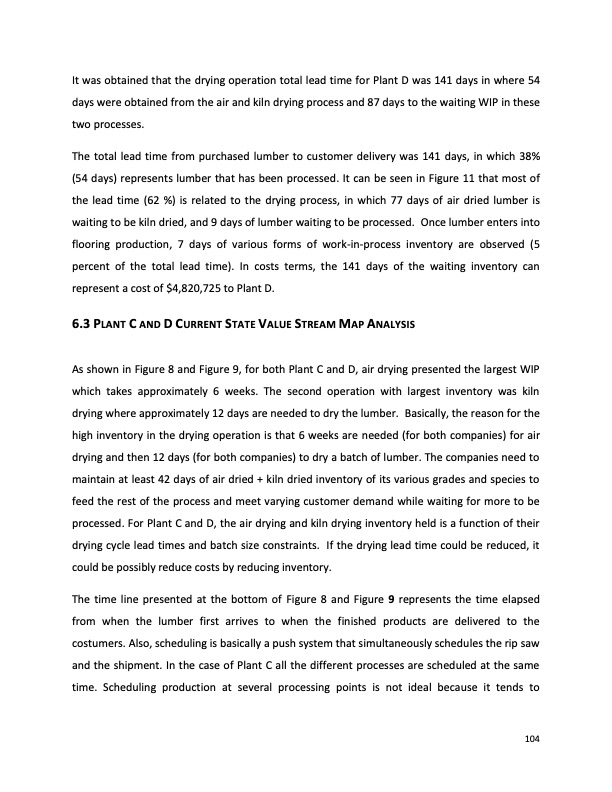
PDF Publication Title:
Text from PDF Page: 114
It was obtained that the drying operation total lead time for Plant D was 141 days in where 54 days were obtained from the air and kiln drying process and 87 days to the waiting WIP in these two processes. The total lead time from purchased lumber to customer delivery was 141 days, in which 38% (54 days) represents lumber that has been processed. It can be seen in Figure 11 that most of the lead time (62 %) is related to the drying process, in which 77 days of air dried lumber is waiting to be kiln dried, and 9 days of lumber waiting to be processed. Once lumber enters into flooring production, 7 days of various forms of work-in-process inventory are observed (5 percent of the total lead time). In costs terms, the 141 days of the waiting inventory can represent a cost of $4,820,725 to Plant D. 6.3 PLANT C AND D CURRENT STATE VALUE STREAM MAP ANALYSIS As shown in Figure 8 and Figure 9, for both Plant C and D, air drying presented the largest WIP which takes approximately 6 weeks. The second operation with largest inventory was kiln drying where approximately 12 days are needed to dry the lumber. Basically, the reason for the high inventory in the drying operation is that 6 weeks are needed (for both companies) for air drying and then 12 days (for both companies) to dry a batch of lumber. The companies need to maintain at least 42 days of air dried + kiln dried inventory of its various grades and species to feed the rest of the process and meet varying customer demand while waiting for more to be processed. For Plant C and D, the air drying and kiln drying inventory held is a function of their drying cycle lead times and batch size constraints. If the drying lead time could be reduced, it could be possibly reduce costs by reducing inventory. The time line presented at the bottom of Figure 8 and Figure 9 represents the time elapsed from when the lumber first arrives to when the finished products are delivered to the costumers. Also, scheduling is basically a push system that simultaneously schedules the rip saw and the shipment. In the case of Plant C all the different processes are scheduled at the same time. Scheduling production at several processing points is not ideal because it tends to 104PDF Image | Impact of Vacuum-Drying on Efficiency of Hardwood Products

PDF Search Title:
Impact of Vacuum-Drying on Efficiency of Hardwood ProductsOriginal File Name Searched:
Brenes_Angulo_OM_T_2014.pdfDIY PDF Search: Google It | Yahoo | Bing
5,000 BF Shipping Container Lumber Dry Kiln For Quality Lumber The 5,000 BF container kiln consists of one 40 foot high-cube aluminum shipping container... More Info
Shipping Container Lumber Dry Kilns by Global Energy Global Energy designed and developed the container kiln back in 1991. The purpose is to give access to portable sawmill owners, furniture makers, and small business the value added profit of dry kiln lumber and quality hardwoods... More Info
Vacuum Kiln Conversion Kit for Lumber and Wood Dry Kilns Convert your existing conventional dry kiln into a fast drying vacuum kiln. Similar to vacuum bagging in the boat building and aircraft industry, we have come up with a proprietary process which allows you to build a very simple vacuum kiln at a fraction of the price, and without the intensive conventional metal chamber structure... More Info
Vacuum Pump Cart System for Bagging Clamping Wood Drying and more Vacuum Cart with 2HP Pump and Dual Pistons with multiple multiplex vacuum ports and liquid reservoir... More Info
Vacuum Bagging Basics Vacuum bagging is a method of clamping, which has traditionally been used in the composites industry, but can also be used for vacuum drying materials, including wood products... More Info
| CONTACT TEL: 608-238-6001 Email: greg@globalmicroturbine.com | RSS | AMP |